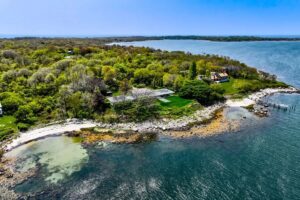
“We can never have enough of nature,” Henry David Thoreau famously declared in the pages of Walden. If that esteemed author-philosopher were to retreat to the woods today, he might well choose this glass-walled oasis on New York’s Fisher Island rather than a meager cottage on the banks of a Massachusetts pond. At the estate known as Hooverness, secluded in an equally idyllic locale, expanses of glass all but erase the barriers between interior living space and nature.
The home’s unique focus can be attributed to its original owner, Thomas N. Armstrong III, whose admiration for art led him to renown for tripling the square footage of the Whitney Museum and whose enthusiasm for gardening ushered in years serving as chairman of the Garden Conservancy. These partnered passions prompted Armstrong to commission a 4,600-square-foot, one-bedroom residence from New York architect Thomas Phifer, known for his commitment to contemporary minimalism and liberal use of glass. These traits transform carefully curated flora, towering trees, and the sea into a form of dynamic art, paying fitting tribute to this milieu, the site of the Armstrong family’s former summer retreat. From nearly every vantage point, the eye rests easily and immediately on organic color or the water as it flows toward the stalwart horizon.
As a coastal gravel drive and low-profile flagstone steps approach the home, steel supports and an unembellished flat roof barely interrupt the outlook, allowing the sightline to continue straight through to the soothing blue of Chocomount Cove and the Connecticut coastline beyond. The home’s few interior walls are designed for and dedicated to art while also being carefully positioned to create distinct spaces for living, dining, and private repose without halting the effortless flow. Even the kitchen’s streamlined surfaces maintain the zeal for minimalism and stylish monochromatic simplicity.
Natural light itself acts as a design element, with the glass walls and six circular skylights illuminating every space—all other lighting comes from floor or tabletop sources. Filtered through a unique metal eave—something of a steel fringe for the roof—sunlight creates striking photographic areas of striated shade on the shallow wraparound terrace. The home is immediately enveloped by an alcoved moss garden and impossibly green lawn, beyond which manicured hedges, mature gardens, copses, and orchards unfurl. An assemblage of apple and linden trees pruned to match the height of the home accompany annual, perennial, and rock garden beds in biomorphic Hans Arpian shapes; two fountained pools; and finally, the rocky shoreline and a stretch of sandy beach. Adding mesmerizing color and fragrance are a variety of Japanese maples, rhododendrons, daylilies, azaleas, peonies, hydrangeas, camellias, irises, daffodils, and cherry, pine, beech, and magnolia trees.
Much like Thoreau’s humble cabin, this residence manifested an important objective for its creator and only resident. “I have always wanted to live in a greenhouse,” Armstrong wrote in the pages of his 2011 book, A Singular Vision: Architecture Art Landscape, continuing that, “in looking at nature I am contemplating the same concepts that I celebrate in art.” Much like literary his predecessor, Armstrong came to a place to live deliberately, in awe of the art of his environs—an invitation now extended to a new devotee and steward.